Asset & Package Viewer
The Asset Viewer Module is where you view and interact with your Packages and Files in CORE. It includes the viewer where a user views and controls the viewing of all files, as well as the various side panels that contain information about the Asset Group, Package, or File being reviewed. This section is about the Asset Viewer and the main components of the module. For more information about the different Side Panels and actions, please proceed to the following Panel sections in this chapter.
Accessing the Asset Viewer
There are different ways to access the Asset Viewer:
- Via the Inbox when you click on a Package
- Via an email notification link that takes you directly to the Package
- Selecting an Asset Group or File in File Search
The Viewer display is slightly different between a Package View and an Asset Group, aka an Asset View. Both versions are listed below, depending on your workflow:
I work from my Inbox, take me to Package View
I work from File Search, take me to Asset View
Access the Asset Viewer from File Search
To view Asset Groups from File Search,
Select the Asset Group Title

The Asset Viewer will pop up showing the files in the Asset Group.

From the Asset View you can interact with the Asset Group through the Side Tabs. See Elements of the Asset Viewer

You can also select a File, and view it in the Asset Player. See Elements of the Asset Player or go to the Quick Guide to the Asset Player

Elements of the Asset Viewer
The Asset Viewer has five main parts:
- Top Bar
- Asset Viewer Display Settings
- Asset Viewer
- Side Bar
- Side Panel
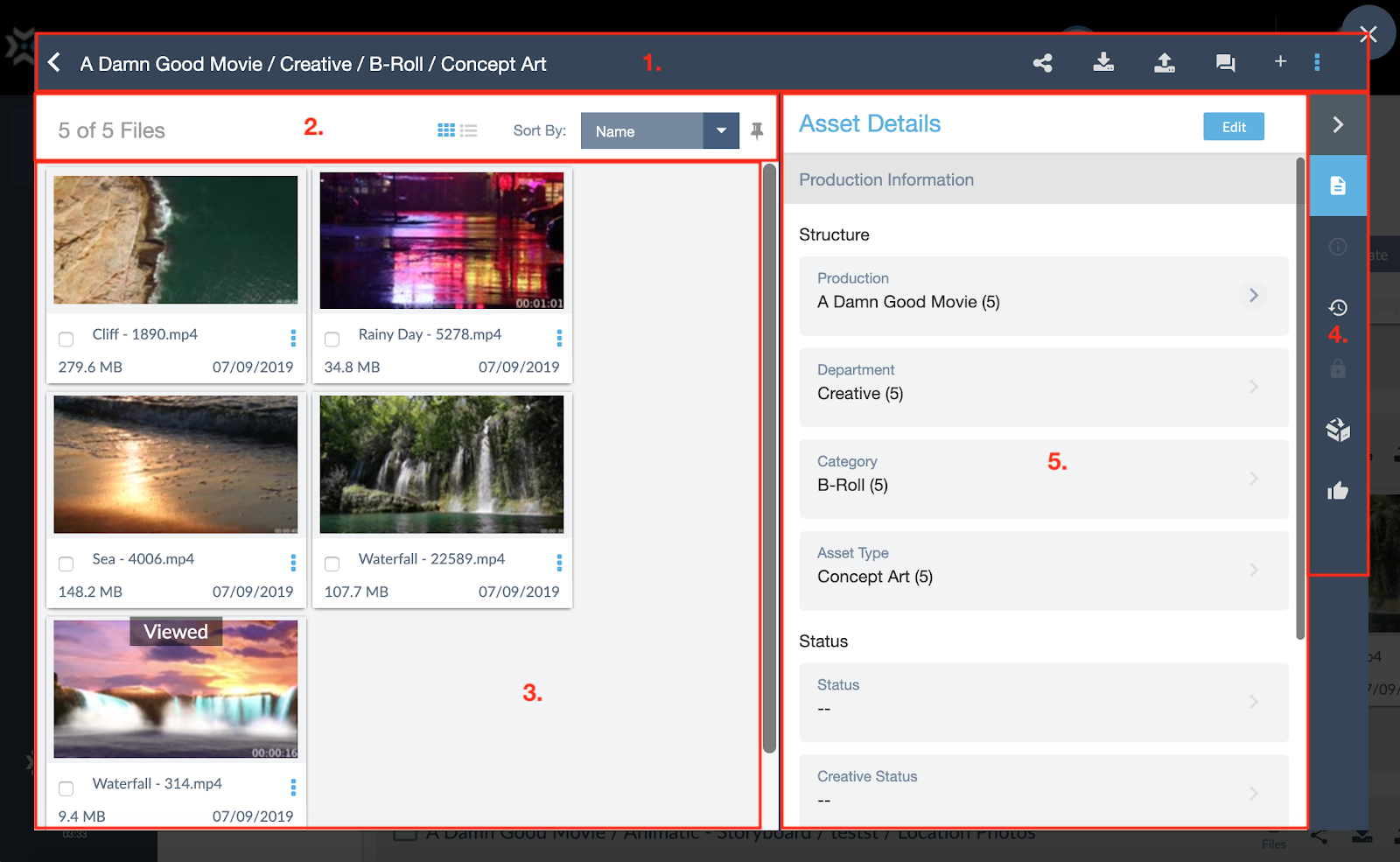
Asset Viewer Top Bar - Asset Group View
The Top Bar provides information about the Asset Group you are viewing along with key navigational controls. What controls you see are dependent upon your permissions or the settings.

- Return - Click here to return to the Asset Group
- Asset Group Name / Structure
- Options - Each icon in this section will open the Side Panel to its respective section. a. Share - Share the contents of this Asset Group with other users. b. Download - Download Asset Group or selected Files. c. Upload - Upload additional files into this Asset Group. d. Discussions - Opens the Discussions and Commenting Panel. e. Add to Package - Adds selected Group or Files to an Active Package. f. Additional Options - Click this to reveal additional options.
Asset Viewer Display Settings - Asset Group View
The Asset Viewer also has a sub-bar area that changes how the Assets are displayed, like in File Search:

- File Count - Shows number of Files in Group
- Thumbnail and List Modes - Switches between the two modes
- Sort by Options - Sorts Asset Group by Position, Name, File ID, Date, Size, Timecode
- Sorting Pin - Saves the preferred Sort By option
Asset Viewer Side Bar
Access the different side panels for the Package, Asset Group, or File from the side bar. Depending on your user permissions, what you see in the Side Bar will vary.

- Collapse or Expand Side Panel
- Asset Details - Opens Asset Details panel
- Package or File Information - Opens Info Panel on the File or Package
- History - Opens Panel showing history of File or Package
- Files Access - Opens Panel showing who has access to File and what Package Shares it’s been included in.
- Recipients - Shows who has received the File or Package
- Package Panel - Opens the Package Panel enabling user to do any number of related actions.
- Export Package Report - Lists reports available for download
- Screener App - Enables user with Screener permissions to project File or Package to another device via the Screener app
- Approval History - Shows who on the package or file has approved or rejected it.
Asset Viewer Side Panel
The Side Panel gives additional information and controls for the File or group of Files that you are viewing. Each of these Panels are accessible from the Asset Viewer Side Bar. For further details, please go to the corresponding Panel sections in this chapter.
CORE Tip: Last Selected Side Panel is Cached When User Returns to Asset Viewer Sometimes users are disoriented by the information they see in the Side Panel when they arrive in Asset Viewer. This is easily resolved. When leaving and returning to the Asset Viewer, the displayed Side Panel is the one that was last open when the user was previously in Asset Viewer. Therefore, if the view is not what you were expecting, be sure to check the Top and Side Bars to select the desired Panel. The selected Panel is highlighted in light blue:
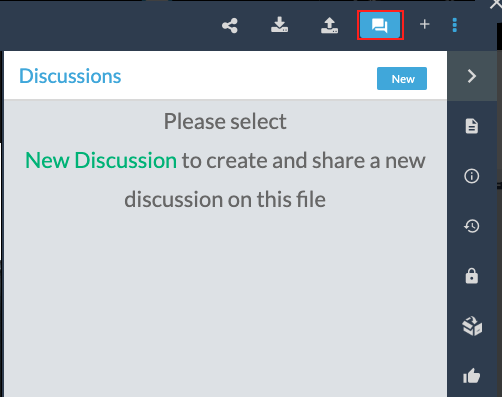
Access the Asset Viewer (aka Package Viewer) from Inbox or a Package Link
The Asset Viewer in the Inbox and when viewing packages is call the Package Viewer because of slight differences you’ll see when viewing a package. To view a package,
Select it from the Inbox or click on the link in your email.
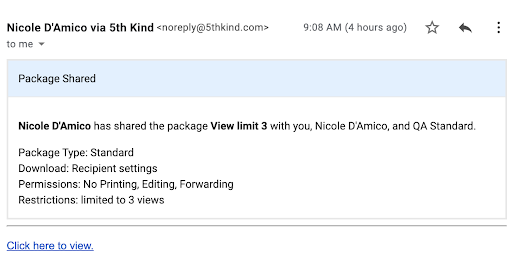
The Package Viewer will pop open.

From the Package View you can interact with the Package through the panels in the Side Panel. See Elements of the Package Viewer

You can also select a File, and view it in the Asset Player. See Elements of the Asset Player or go to the Quick Guide to the Asset Player
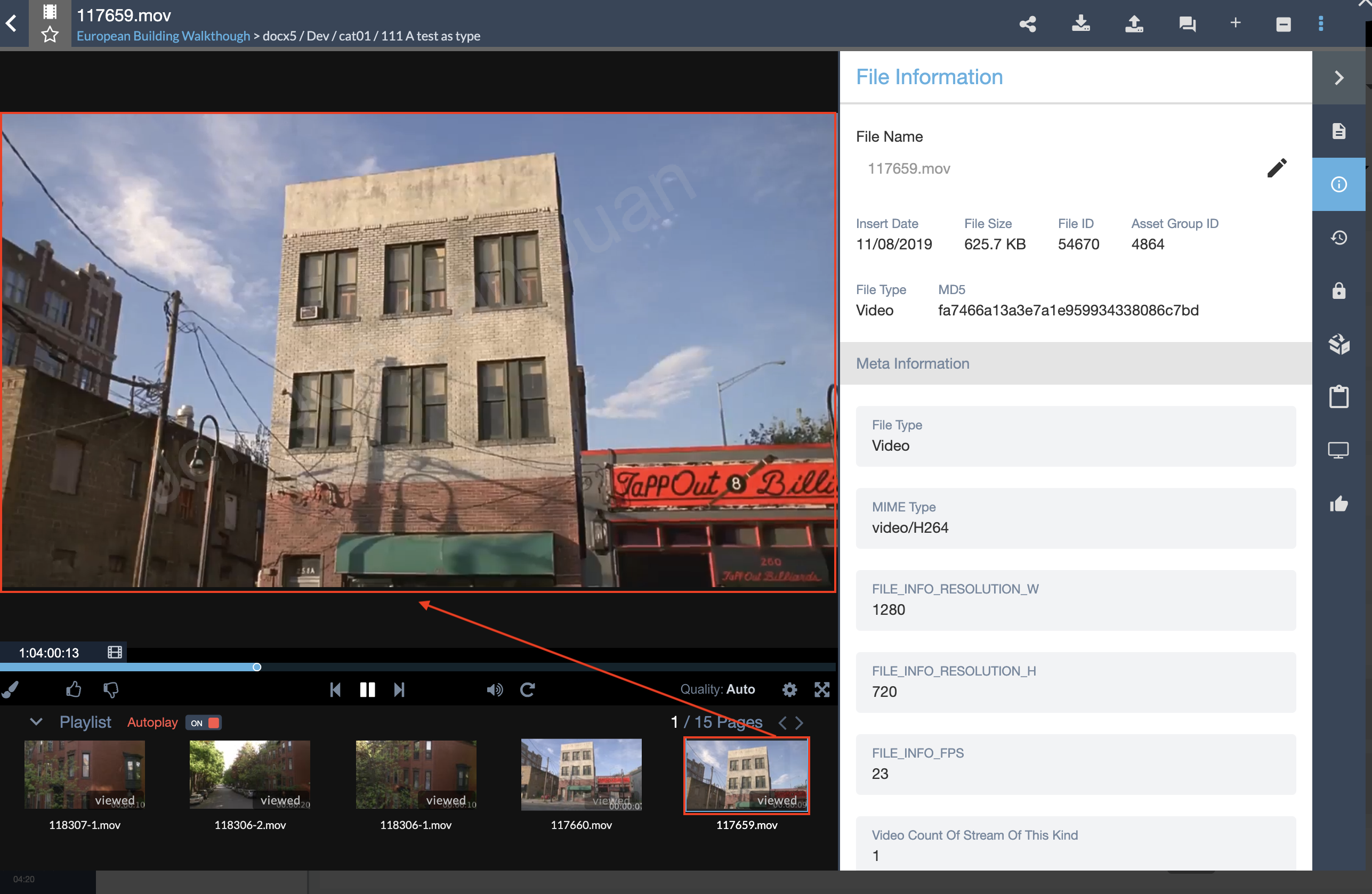
Elements of the Package Viewer
The Package Viewer has five main parts:
- Top Bar
- Package Viewer Display Settings
- Package Viewer
- Side Bar
- Side Panel
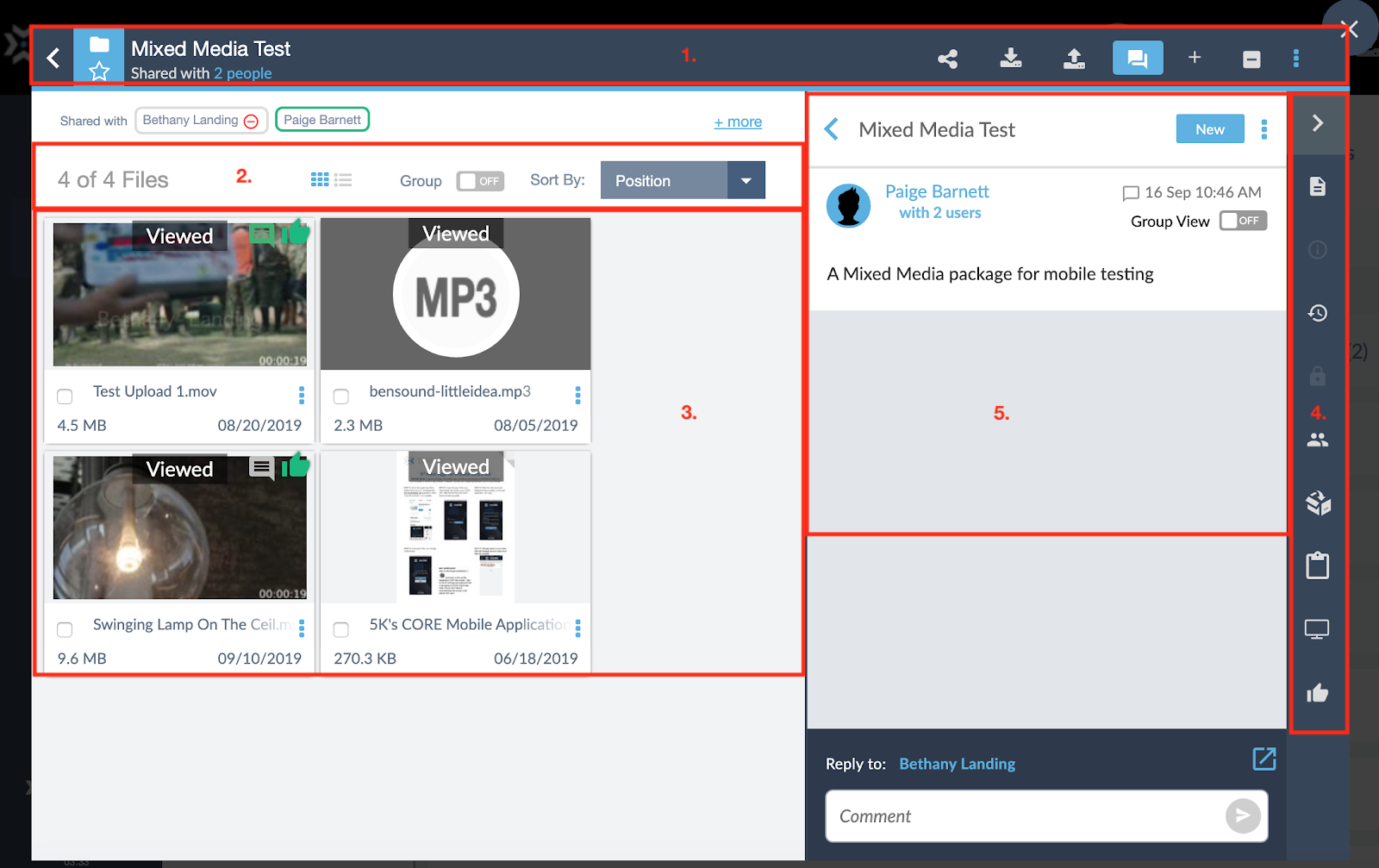
Package Viewer Top Bar - Package View
The Top Bar provides information about the Package you are viewing along with key navigational controls. What controls you see are dependent on your permissions or the settings.

Return - Click here to return to the Package Inbox
Package Icon- Shows this is a Package. Icons denote the package type: Feedback (standard), Dailies, Approvals, Sync Review and Download
Favorite - Click the to set the Package as a Favorite. If a Package is set as Favorite, it will appear in the Favorites filter in the Package Inbox.
Package Name - Click this to view all contents of the Package in Asset View Mode .
Shared with - Shows the number of users on the Package. This is selectable on Standard Packages to show the other recipients on the Package.
Options - Each icon in this section will open the Side Panel to its respective section. a. Share - Share the contents of this Asset Group with other users. b. Download - Download Asset Group or selected Files. c. Upload - Upload additional files into this Package.Asset Group. d. Discussions - Opens the Discussions and Commenting Panel. e. Add to Package - Adds selected Group or Files to an Active Package. f. Additional Options - Click this to reveal additional options.
Package Viewer Display Settings - Package View
The Package Viewer also has a sub-bar area that changes how the Assets are displayed, like in File Search:

- Shared with - Lists the users shared on the Package. A green outline indicates if they have yet to view the Package. The outline turns grey once the recipient has opened the Package.
- +more - Opens a Recipients Side Panel showing who received the Package.
- File Count - Shows number of Files in Package or number of Asset Groups in Package.
- Thumbnail and List Modes - Switches between the two modes.
- Group Mode Toggle - Switches Group Mode on and off.
- Sort by Options - Sorts Asset Group by Position, Name, File ID, Date, Size Timecode
Package Viewer Side Bar
Access the different side panels for the Package, Asset Group, or File from the side bar. Depending on your user permissions, what you see in the Side Bar will vary.

- Collapse or Expand Side Panel
- Asset Details - Opens Asset Details panel
- Package or File Information - Opens Info Panel on the File or Package
- History - Opens Panel showing history of File or Package
- Files Access - Opens Panel showing who has access to File and what Package Shares it’s been included in.
- Recipients - Shows who has received the File or Package
- Package Panel - Opens the Package Panel enabling user to do any number of related actions.
- Export Package Report - Lists reports available for download
- Screener App - Enables user with Screener permissions to project File or Package to another device via the Screener app
- Approval History - Shows who on the package or file has approved or rejected it.
Package Viewer Side Panel
The Side Panel gives additional information and controls for the File or group of Files that you are viewing. Each of these Panels are accessible from the Asset Viewer Side Bar. For further details, please go to the corresponding Panel sections in this chapter.
CORE Tip: Last Selected Side Panel is Cached When User Returns to Asset Viewer
Sometimes users are disoriented by the information they see in the Side Panel when they arrive in Asset Viewer. This is easily resolved. When leaving and returning to the Asset Viewer, the displayed Side Panel is the one that was last open when the user was previously in Asset Viewer. Therefore, if the view is not what you were expecting, be sure to check the Top and Side Bars to select the desired Panel. The selected Panel is highlighted in light blue:

Package Viewer Package Types
Standard Package View Standard Packages display in the Package View with all Files and Asset Groups listed or shown as thumbnails. From this view, the user can play through the Files or select the File they want to view.
Dailies Package View Dailies Packages autoplay like a playlist moving through each file consecutively. Users can pause and jump around the playlist, as well as go back to a Package View, but they cannot see who else the Package has been shared with.
View Files in the Asset Player
When you select a File in an Asset Group or from the Asset or Package Viewer, that File opens in the Asset Player (sometimes called the Player or Viewer).
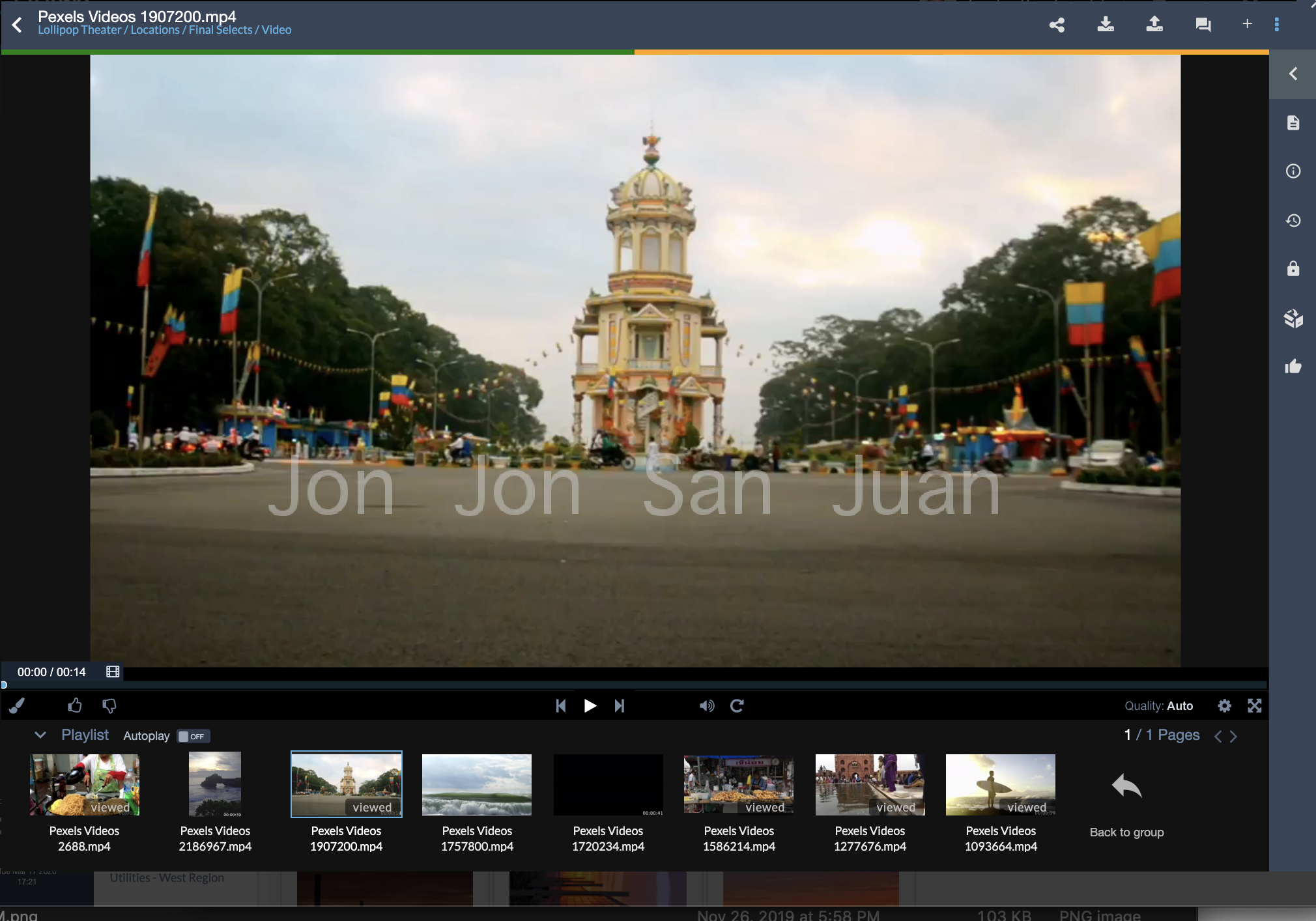
Asset Player Top Bar
File View in Package

File View in an Asset Group or From File Search

- Return - Click here to return to the Package Viewer or Asset Viewer
- Package Icon - Shows this File belongs to a Package
- Favorite - Select to add to your Inbox Favorites
- File Name - Name of the File
- Package Name - Name of the Package
- File Structure - Structural File Path for this File
- Options - Same as the Asset or Package Viewer a. Share - Share the contents of this Asset Group with other users. b. Download - Download Asset Group or selected Files. c. Upload - Upload additional files into this Package. d. Discussions - Opens the Discussions and Commenting Panel. e. Add to Package - Adds selected Group or Files to an Active Package. f. Additional Options - Click this to reveal additional options.
Asset Player Controls & Shortcuts
Asset Player Controls - Video & Audio Only
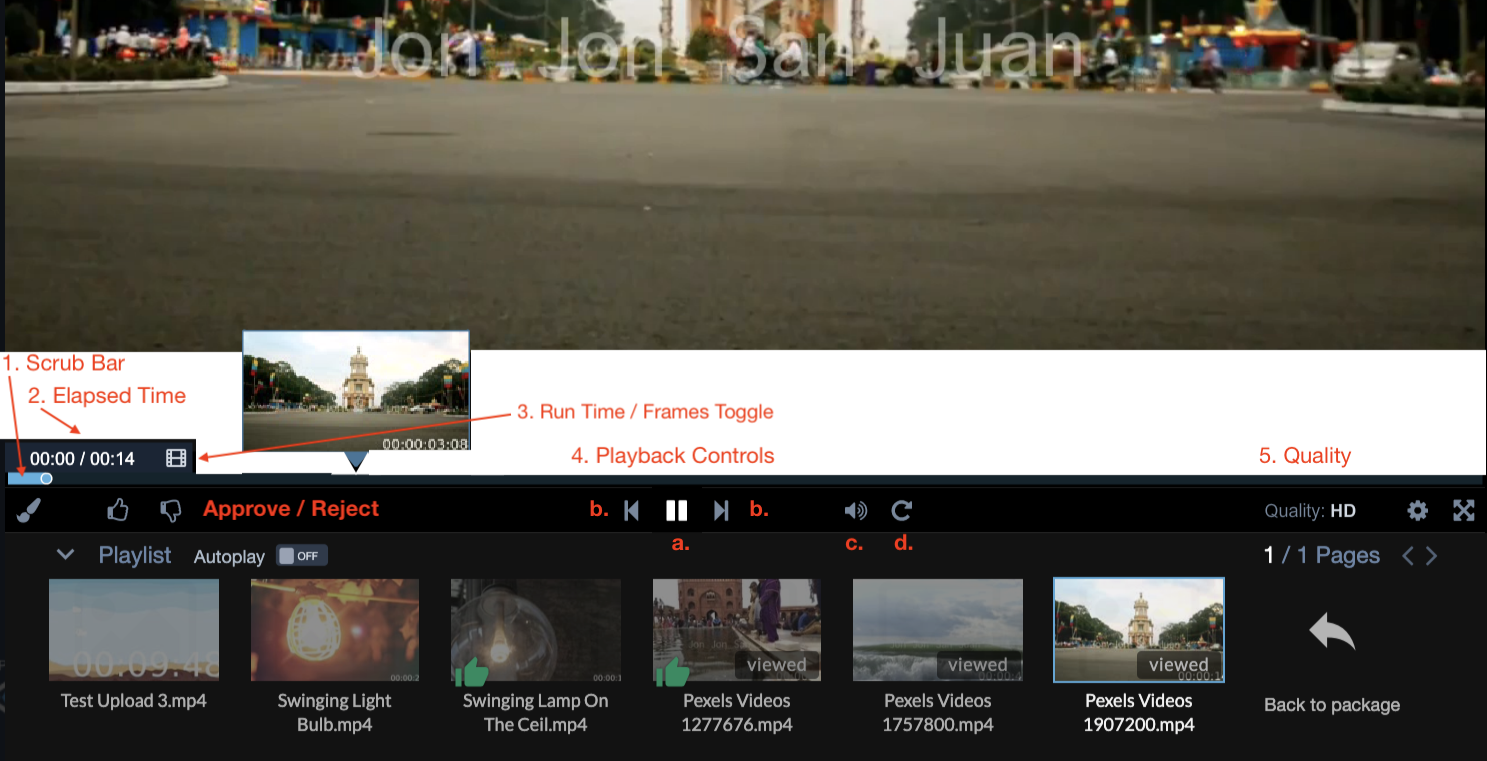
- Scrub Bar - Drag and drop the bar cursor to anywhere in the video or audio file.
- Elapsed Time - Shows elapsed and total run time of the file.
- Run Time / Frames Toggle - Click on the icon to toggle between time and frames.
- Playback Controls - Controls the playback of the current file. a. / Play or pause the current video. b. / Previous File / Next File c. / Mute / Unmute d. Loop Playback
- Quality - Click the Gear icon to toggle between HD and SD quality image in the Viewer.
Asset Player Controls - Documents

- Zoom View - Zoom into and out of the document in the Viewer
- Page Count - Shows the total number of pages in the document. Enter a number in the box of the first number to jump to that page.
Asset Player Controls - All Files

- Annotate - Opens the annotation menu
- Approve / Reject - Click / to Approve / Reject the current File.
- Fullscreen - Click to view the playlist in Fullscreen Mode. To leave Fullscreen Mode, press the Esc Key.
- Playlist - Shows the files in the current Playlist. Select / to expand or close the Playlist. Select a file in the Playlist to view it.
- Autoplay - Sets your files to autoplay when turned ON
- Playlist Page Select - If there are more files in the playlist than can fit on the current page, use the / controls to view more pages of files.
Asset Player Controls - Keyboard Shortcuts
- Space Bar button- Play and stop selected video
- Right Arrow Button - Click skip to the next asset
- Left Arrow Button - Click to go to the previous asset
Annotation Controls
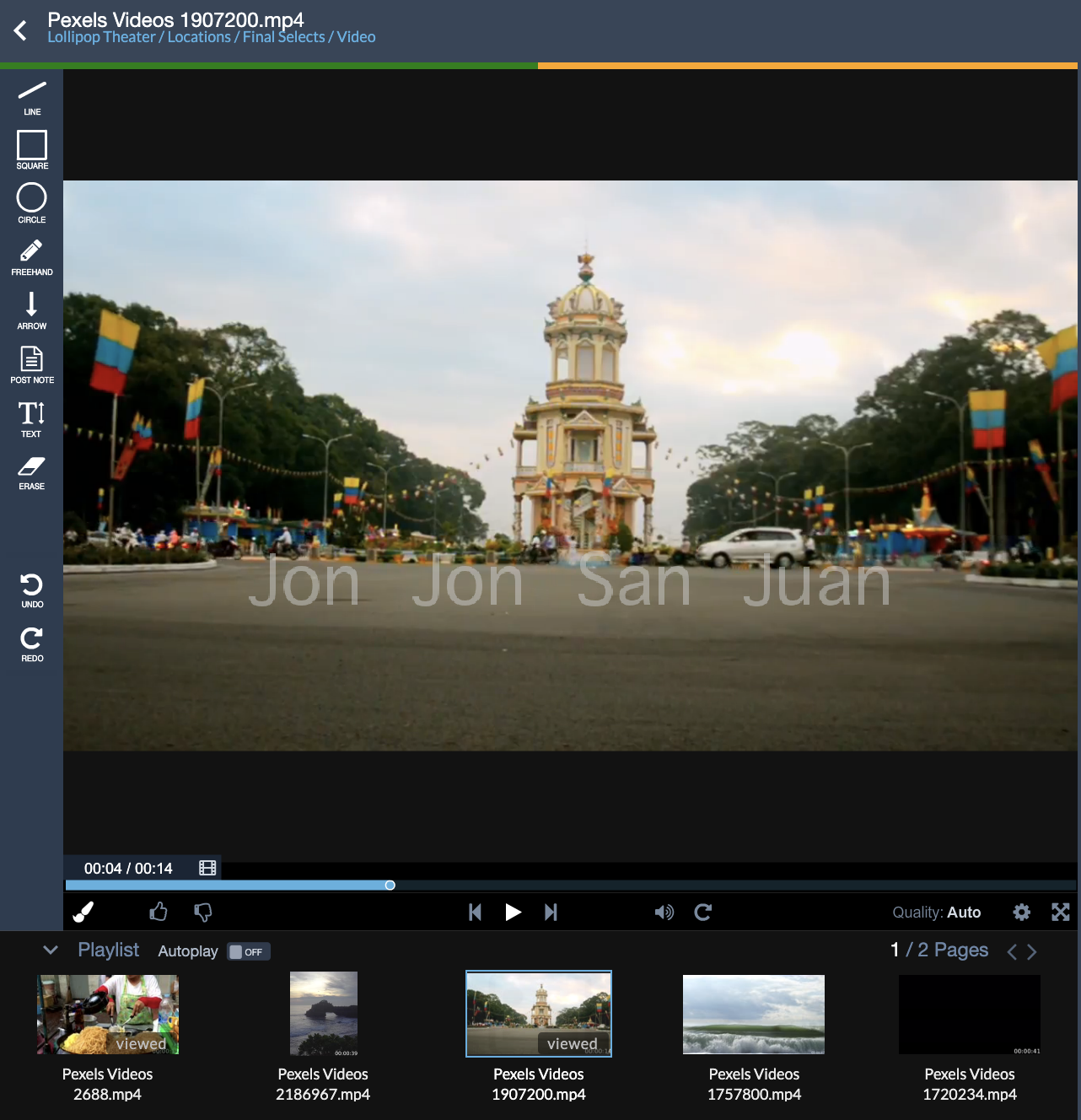
- Line - Use this tool to add lines
- Square - The Square tool allows users to create simple square shapes for highlighting information.
- Circle -The Circle tool allows users to create simple circle shapes for highlighting information.
- Freehand -The Freehand tool creates free-form drawing
- Arrow - The Arrow tool allows users to create an arrow to connect point of interest/highlighted information.
- Post Note - The most common type of comment is the Post note. The Post Note feature is a tool which creates a note attached to the image. Select the Post Note tool in the toolbar, and click where you want to place the note.
- Text - Use the Text Comment tool to type text anywhere on the image
- Erase - Use the Erase tool to erase any annotated tools on the image
- Undo - Undo last function
- Redo - Redo last function
Quickly & Easily View Files
View Multiple Asset Groups in the Asset Viewer
To break out your Files by their Asset Group,
- Turn on Group Mode in the Asset Viewer.

- Files will appear in their Asset Groups

View a File Directly From File Search
To view a single file from File Search, select the File and it will open in the Asset Player.
Find Asset Details
All Tags for a File are listed in Asset Details. To find the Asset Details of a group of Assets or single Asset,
- Select the Asset Group
- Go to the Asset Details icon in the Side Bar and select it
- The panel will open and show you the combined tags for all the Files in that Asset Group
To see the Asset Details of a selection of Files,
- Select the Files in Asset Viewer
- Go to the Asset Details icon in the Side Bar and select it
- The panel will open and show you the combined tags for all the selected Files
To see the Asset Details of a single File,
- Select the File from File Search, you Search Results, or within the Asset Viewer / Package Viewer.
- Go to the Asset Details icon in the Side Bar and select it
- The panel will open to show you the Tag Values for your selected File
If you’re looking for the native file specifications associated with the original source file, go to File Info icon.
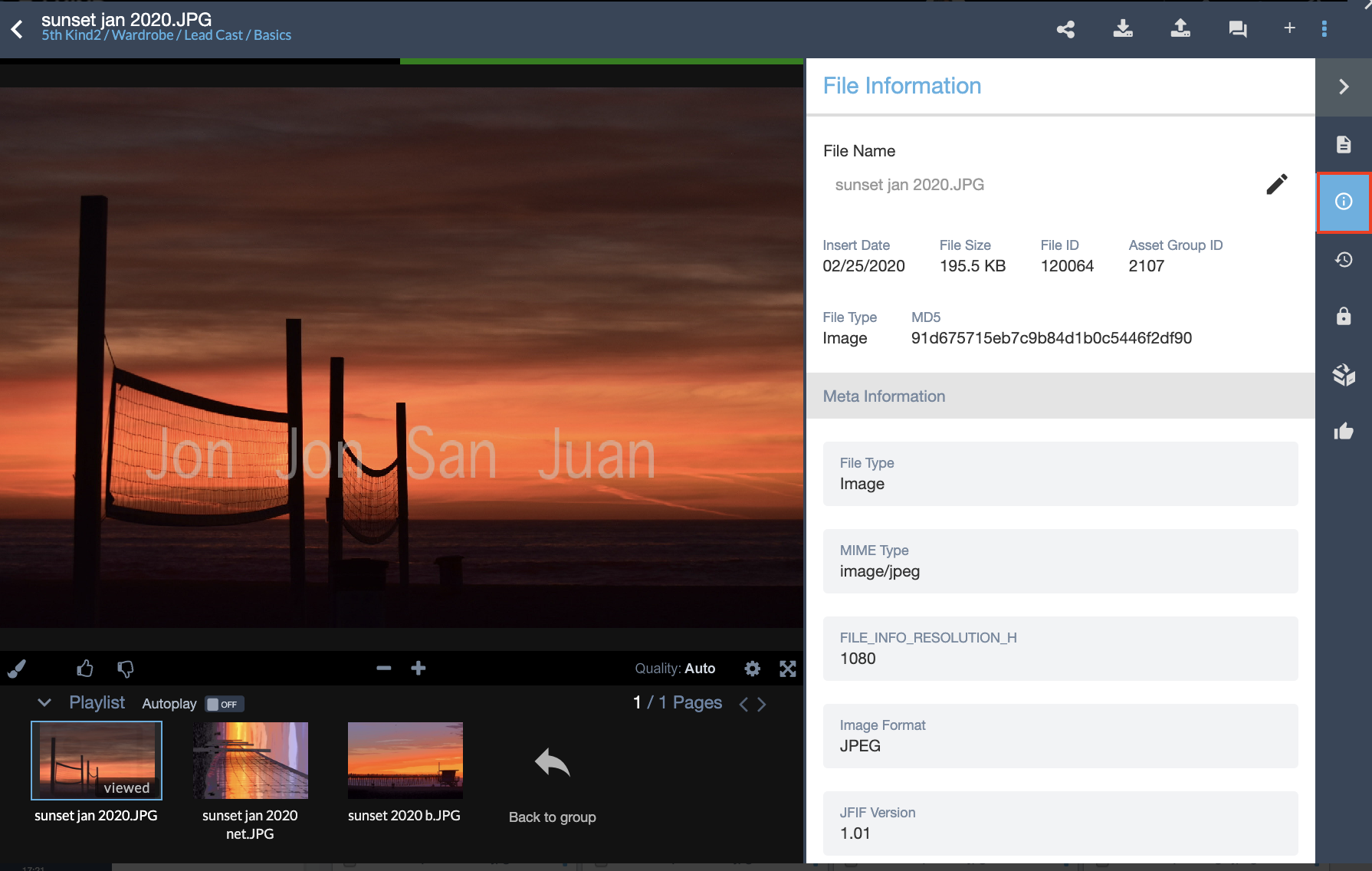
Create a Subclip From a Video
To create a subclip,
- Go to the gear icon on the Asset Player controls
- Select Sub Clip in the menu
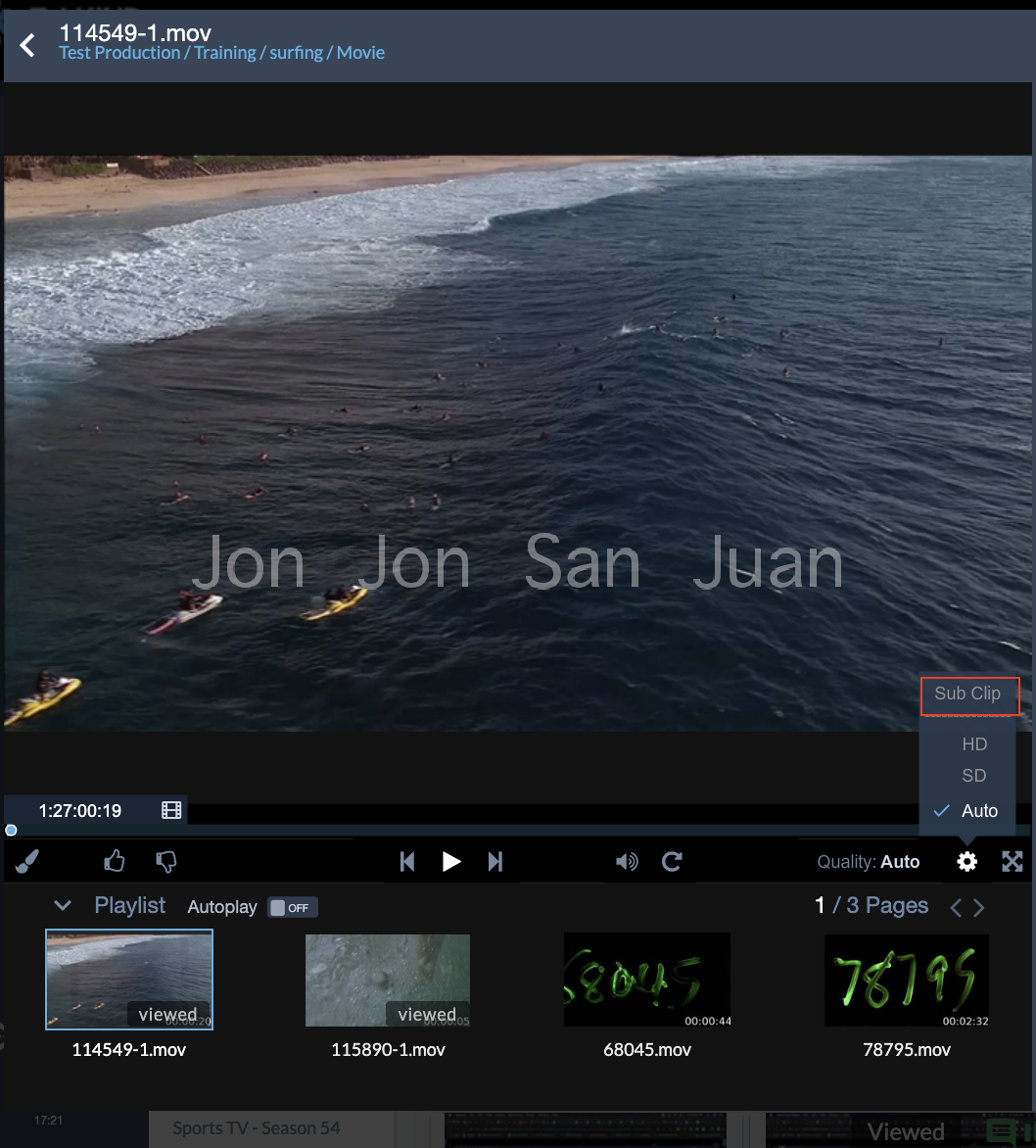
- An arrow marker will appear on either side of the Player’s Scrub Bar
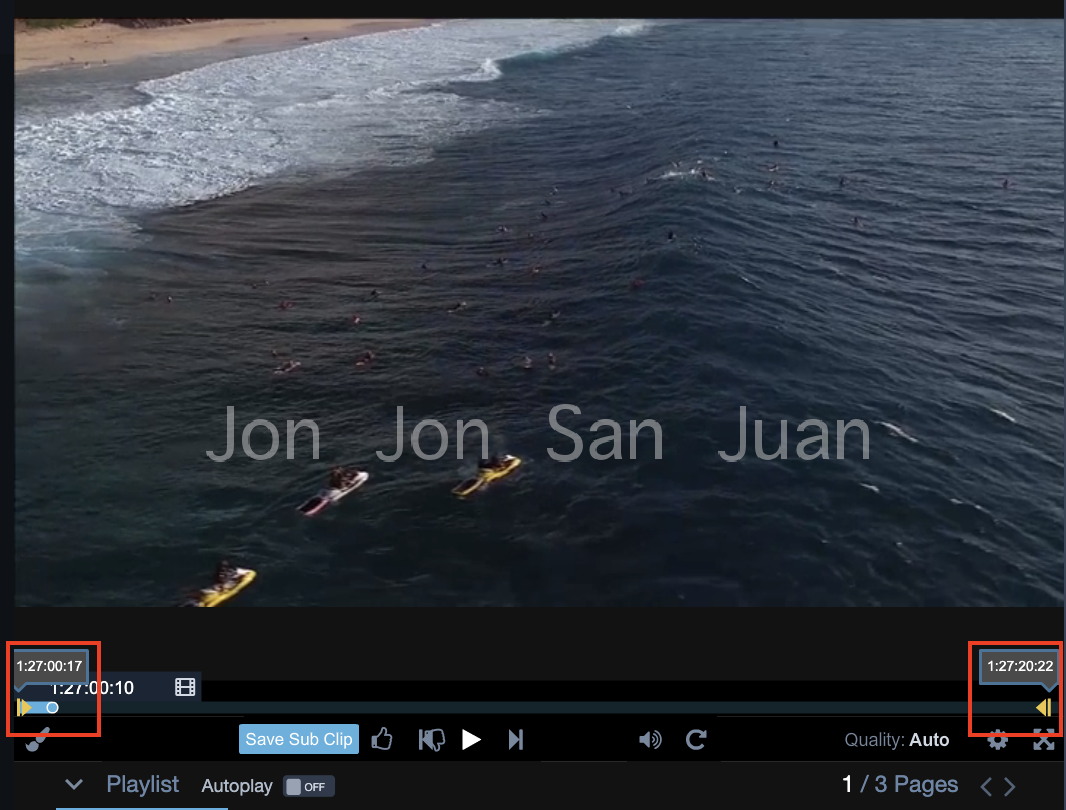
- Move the markers to your desired timecodes
- Select the blue "Save Sub Clip" button

- The Upload Viewer will open while your subclip is creating
- Categorize the clip or Skip & Share it
- Once it’s categorized, the Sub Clip will now appear in your desired Asset Group and can be added to other Packages
See Who A File or Package Has Been Shared With
Go to the Recipients Panel, accessible via the Side Bar. If that icon is not available, you don’t have user permissions to see the Recipients.
View & Play a File
Some Packages are set to automatically start playing when the recipient user opens it. If yours does not, select the File you wish to view. Document files scroll up and down. Video and audio files can be controlled via the player controls.
Scrub Through a Video or Audio File
Scrub through a video by dragging the cursor in the scrub bar to the location you desire.
 Frame thumbnails will appear as you drag the cursor to aid in your search.
Frame thumbnails will appear as you drag the cursor to aid in your search.
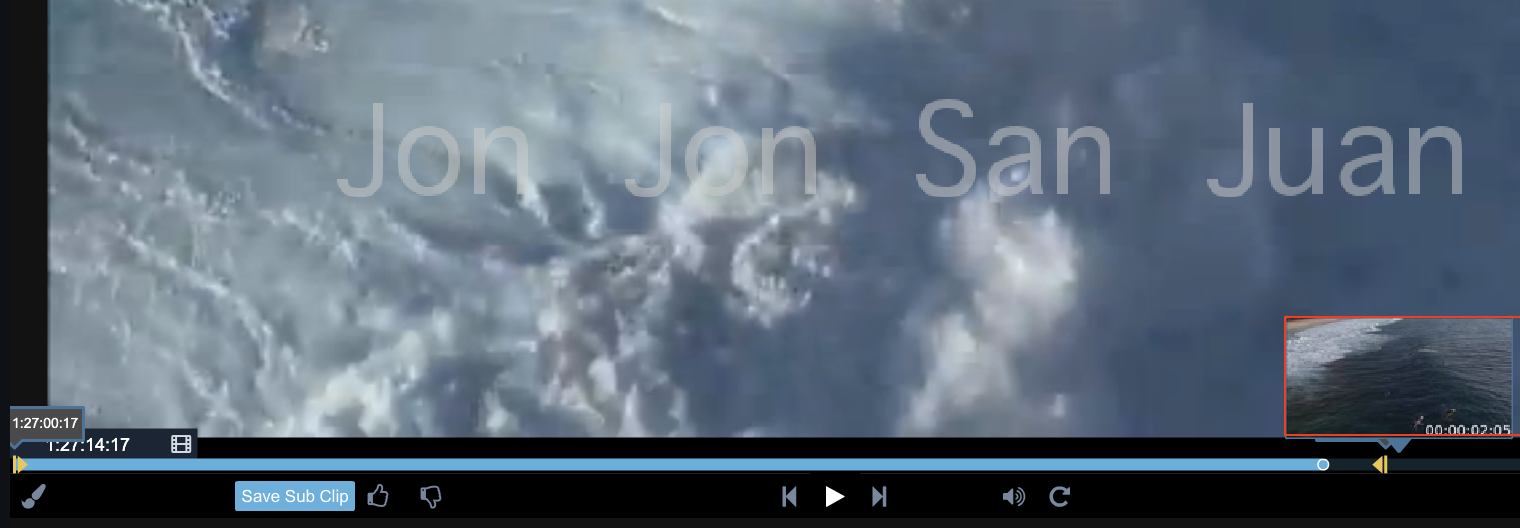
Scrub Through a Large Package or Asset Group
In large packages where you have more than one page to your Package’s Playlist, use the Pages arrows to find the File you want to open next.

NOTE: If you are playing a video while searching for a file and the next video starts, you will be bounced back to that file in the Playlist. To avoid this, turn off Autoplay and Pause the video or audio file, before scrolling through the Playlist.
Comment on a File
- In a package, select the file you want to comment on.
- Add your comment which will be sent to the other users on that package.
- Send.
If the comment panel isn’t open for whatever reason,
- Select the Discussions icon if it’s not selected.
- Select the Discussion you want to comment on OR select New Discussion, if this is the first comment in this package. If it’s new, select the discussion recipients.
- Then comment on your file.
- Send.
Approve a File
With the file you want to approve open in the Viewer, select the thumbs up or thumbs down icon.
NOTE: Currently, everyone is able to approve or reject files. You should be approving only the files you’ve been asked to review. In later phases of this module, when needed, you’ll be granted permissions to approve certain files.
Annotate a Video or Audio File
To annotate a streaming file,
- Click the brush icon on your paused or playing file.
- Select your desired annotation tool.
- Your cursor will change to an editing tool icon.
- Annotate as you desire.
- Add the recipients to receive the annotation,
- Change the subject if you like.
- Add a message.
- Send.
Annotate an Image, PDF, or other Static Files
To annotate a static file,
- Click the brush icon on your paused or playing file.
- Select your desired annotation tool.
- Your cursor will change to an editing tool icon.
- Annotate as you desire.
- Add the recipients to receive the annotation,
- Change the subject if you like.
- Add a message.
- Send.
Change Play Quality of Video
Depending on your bandwidth, your video player quality will be automatically selected. However, if you wish to change it, select to the Gear icon. Choose HD or SD.
Enter & Exit Fullscreen Mode
Select the Fullscreen icon to go into Fullscreen Mode. Hit esc (escape) to exit the mode.
Turn Auto-Play On & Off
Flip the Autoplay toggle to turn it on, which will automatically play all items in the playlist one after the other until the end. Or toggle it off and you can manually choose which file you would like to view next.

Close and Open the Playlist at the Bottom of the Screen
Use the down and up arrows next to Playlist to collapse and expand the playlist.
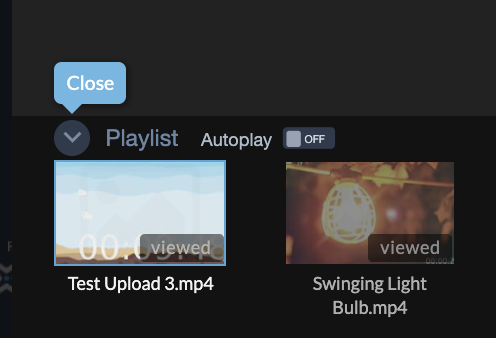
Media/File Specifications on Asset Viewer Proxy Viewing
Here are the specifications for the various proxy file/media types when viewing on CORE.
Proxy Media Specifications
| Parameter | Specifications |
|---|---|
| Video | HD 1280 x 720 SD 480x360 |
| Images | Print (HD) - 2000x2000 Web (SD) - 800x800 Thumbnails - 200x200 (thumbnails in JPG format) |
| Audio Playback | Playback in MP3 audio |
Proxy Document File Specifications
| Parameter | Specifications |
|---|---|
| Most document File Types (.doc, .xls, .ppt, .pdf, etc) | When viewing or downloading proxy file documents in CORE, these documents are converted to PDF on view/download |
Troubleshooting
I Can Only See My Package as Playlist in the Player
If you received a Package that opens directly into the Asset Player, then that file was sent to you as a Dailies (also called Playlist) package. This means you won’t be able to access the Package Viewer. You can, however, turn off the autoplay functionality to peruse the files at your own pace.
My Package Won’t Open in Package Viewer
If your package opens, but only in the Player, see above. If your package won’t open when you click on it from your Inbox, go to Troubleshooting in Package Inbox.
My File Won’t Play or Open
There are many reasons why a video or other files won’t play: slow internet, firewall issues, or the file hasn’t processed yet. Here are a few items you can test on your own before escalating your issues to Support:
My Thumbnail Shows Uploading or Processing & Video Won’t Play
If the thumbnail shows that it’s still processing and the video won’t play,
- Check the size of your source file. File processing on CORE occurs at the rate of 6x-8x the length of a video file. Larger files could take 20 minutes or more to process.
- If you didn’t upload the file, select the History Panel icon to see what time the file was uploaded. You don’t want to reprocess a recently uploaded file. It may need more time to complete.
If it’s been longer than what’s reasonable for the size of your file, then first try to reprocess your file.
- Select the File
- Go to the Asset Player
- Select the More / Three Dot icon in right corner of the Top Bar
- Select Reprocess Add Image
- Once you reprocess the File, refresh the page. If the file is a long file, i.e. 2 hours, give it about 10 minutes to reprocess.

If Reprocess is not selectable, or the file doesn’t still doesn’t work after reprocessing, escalate the issue to your Tier 1 Support Team. Provide Support with the following information from File Info :
- FileName
- File ID
- MD5 Checksum
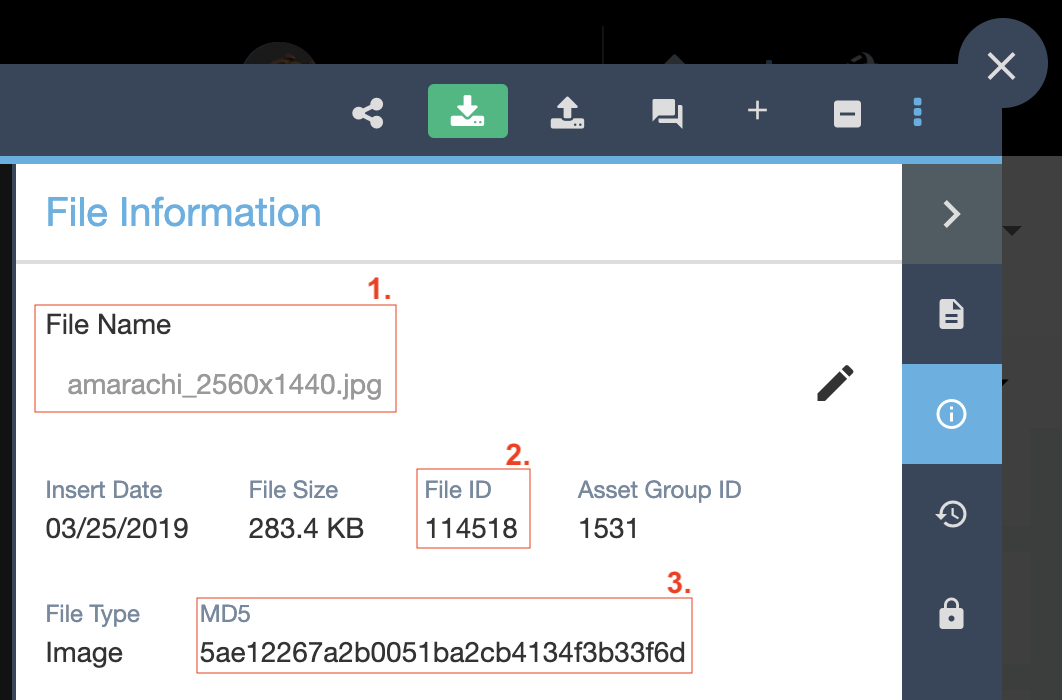
NOTE: If there is no MD5 number, the file was interrupted in some way during the upload process, and did not complete uploading into the system. Re-upload your file, or contact the original uploader to alert them. If you continue to have this problem with the same file, alert your support team.
My Thumbnail Appears, but File Won’t Play or Open
Try the same steps as above.
- This time, first check if there’s an MD5 number.
- If there is, follow the reprocessing instructions. If there is no MD5 number, re-upload the file or alert the original uploader. My Thumbnail Appears, and File Opens / Plays, but Then It Stops Try reprocessing this File, per the instructions above. If that doesn’t resolve the issue, escalate this to your support team who can provide additional assistance or investigate further.
My File Says It “Failed to Load Watermark”
In the CORE Asset Player, the browser may ‘cache’ a video that you tried to watch earlier that may have had an issue streaming. In this case, if you’re in the player and you receive a black screen with red message saying, Failed to Load Watermark, do the following:
- Logout
- Clear your cache for the last day or 24 hours
- Reboot your browser window
- Log back in
If the issue persists, gather the File Name, File ID, and MD5 number per the instructions above and pass it along to your support team. Let them know you have already followed steps 1-4 here, and they can escalate the issue for further investigation.
My Video is Buffering a Long Time
Slow video buffering can be worked around by switching between your File’s high and low resolution proxies. To buffer your video more quickly, select the low res proxy by going to the Asset Player’s controls.
- Select the Gear icon
- Select SD, the low res proxy.
If this solution doesn’t work, contact your internal 5th Kind CORE Support contact.
